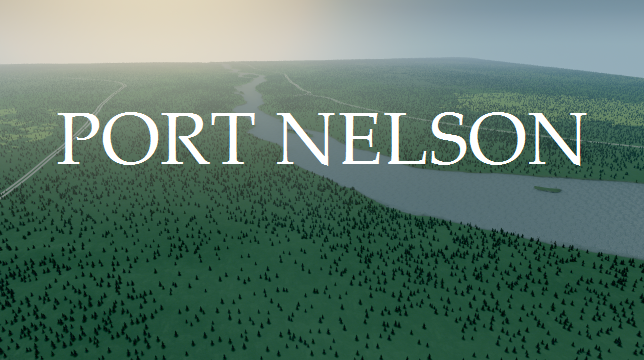Port Nelson
Port Nelson lies on the shore of Hudson Bay, in Manitoba, Canada, at the mouth of the Nelson River. Its peak population in the early 20th century was about 1000 people but today it is a ghost town. Immediately to the south is the mouth of the Hayes River and the settlement of York Factory.
Port Nelson was named by Thomas Button who wintered there in 1612. "August 15, 1612 Captain Thomas Button seeking for a harbour on the west coast of Hudson’s Bay in which he might repair damages incurred during a severe storm, discovered the mouth of a large river which he designated Port Nelson, from the name of the master of his ship whom he buried there."
It was during the period from 1660-1870 when many Assiniboine and Swampy Cree trappers and hunters became middlemen in the Hudson’s Bay Company fur trade economy in Western Canada. Using the Nelson River, along with the Hayes River, as the main inland routes to the great inland lake, Lake Winnipeg. Although the Nelson is much larger, the Hayes was a better route into the interior. Therefore, most of the Hudson’s Bay Company’s trade was done from York Factory on the Hayes.
In the early 1900s, the Government of Canada felt that a major harbour on Hudson Bay was needed for shipping grain from central Canada. In 1912 Port Nelson was selected as the site over Churchill (at the mouth of the Churchill River to the north) to become the terminus of the Hudson Bay Railway, the construction of which had already begun from The Pas in 1910.
In the winter of 1912-13 the site was surveyed and construction of a wharf began in the spring, followed by buildings and other infrastructure built during the summer. The brand new Canadian research ship CSS Acadia was sent from Halifax to chart the harbour and approaches in the summer of 1913 and 1914. However the whole harbour project was fraught with problems from the start. Material shortages, labour disputes, storms, fires, and boating accidents led to major delays. Another setback was the necessity to completely redesign the harbour because the fast flowing Nelson River was building up silt on both sides of the wharf. Therefore the harbour was changed to a small man-made island farther out in the river, connected with a seventeen-span truss bridge
When Canada entered the First World War, it resulted in further material and labour shortages, and more significantly, the loss of political and financial support. The project was able to continue a few more years until 1918 when all work stopped and the site was abandoned. The whole project was greatly criticized by several politicians, the media (calling it a "gigantic blunder"), and even the project’s chief engineer.
The Hudson Bay Railway never reached Port Nelson and its tracks lay abandoned until 1927 when Churchill was chosen to become the northern shipping hub. Construction was restarted and completed by 1929.
Read more about Port Nelson here.[www.mhs.mb.ca]
– Boreal themed map, mostly flat with gentle hills sloping down towards the river.
– All connections.
– Roughly 150k trees.
– All and plenty of resources.
– I recommend using a 25-tile mod.



